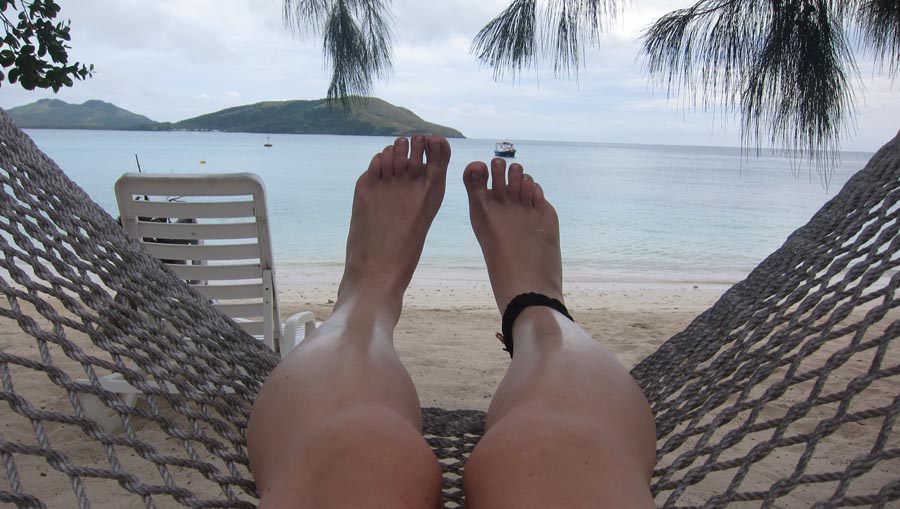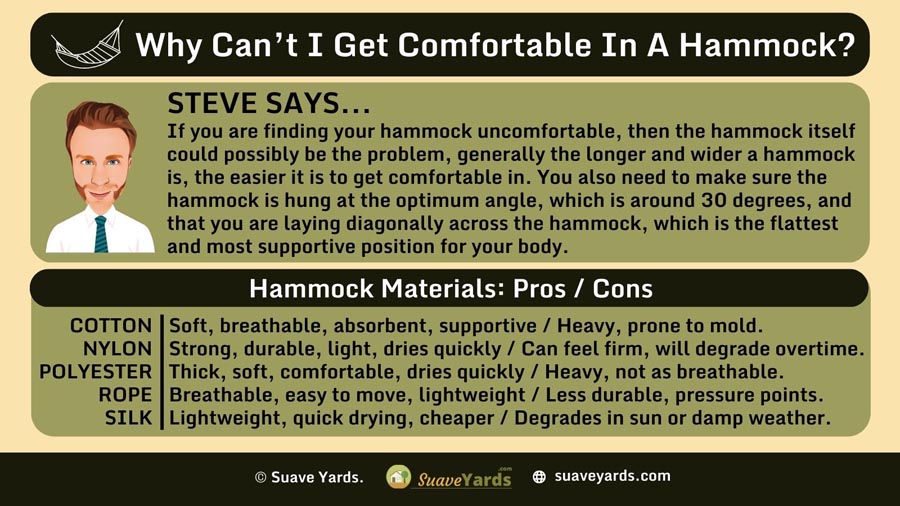
We have all been there.
After a busy day, you are set for a night outside camping. You climb into your hammock feeling exhausted and ready to sleep.
And then you can’t get comfortable, and you can’t sleep.
So why can’t you get comfortable in a hammock?
We will investigate that and a few other related questions in today’s blog.
Let’s get started.
If you are finding your hammock uncomfortable, then the hammock itself could possibly be the problem, generally the longer and wider a hammock is, the easier it is to get comfortable in. You also need to make sure the hammock is hung at the optimum angle, which is around 30 degrees, and that you are laying diagonally across the hammock, which is the flattest and most supportive position for your body.
Why is My Hammock Uncomfortable?
There are a whole number of reasons you could be struggling to get comfortable in your hammock.
Some will be to do with your hammock, some will be to do with you and some will be totally external factors.
Maybe the first thing you should consider is…
#1: The Length
A question that is often asked is ‘Are longer hammocks more comfortable?’, and for me, the answer is an unequivocal, yes!
When it comes to comfort and sleeping, hammock length is the most important factor in my experience.
The difference between getting comfortable in a 9-foot hammock, and getting comfortable in an 11-foot hammock is night and day.
The 11-foot hammock gives you an extra two feet of space to get into that ideal position when you lay down to sleep.
If you can afford a larger hammock I always recommend it.
#2: The Width
And on the same vein, hammock width makes a big difference to your comfort levels.
Wider hammocks give you more room, which can be especially beneficial if you are on the larger side yourself.
As with hammock length, a wider hammock will make it easier for you to get into a comfortable position when you are relaxing.
Some hammocks come in regular and extra wide versions, so this is another factor to consider.
#3: The Hang Angle
How tight or slack is the hang of your hammock?
If you hang your hammock too tightly it will cause a cocooning effect that will squeeze the sides of your body and make you uncomfortable.
If you hang your hammock too loosely, you will end up sleeping in a banana shape which will be uncomfortable on your back, and you will probably start sliding down toward your feet in your sleep.
Ideally, you want your hammock to be hung at roughly a 30-degree angle, this gives you a good center of gravity and will allow you to lie in a better position.
Speaking of which…
#4: Your Sleeping Position
Once you get your hammock hung at something around a 30-degree angle, you then want to sleep diagonally across it.
This allows you to lie flat, with your head slightly elevated above the rest of your body.
Your weight will also be distributed more naturally across the hammock, and it will prevent the sides of the hammock from cocooning in.
To find the perfect position, lie directly down the center of the hammock.
Then move your feet and legs around one foot to one side. They should now be sitting lower than they were.
Now move your head and torso one foot to the opposite side, so you are on a diagonal.
Hopefully, you should be lying almost completely flat on the hammock now!
#5: You Need to Give It Time
If you are new to using a hammock, then you often simply have to persevere and give yourself time to get used to it.
For most people, it will take time for their bodies to adjust.
Think about if you have ever bought a new bed. You might have slept for years or even decades on the previous one and it can take some time to adjust to a new bed.
Trying to get used to sleeping in a hammock after using a bed all your life is a different matter altogether!
For most people, it will take a lot of practice to adapt to the very different environment a hammock provides.
#6: The Movement Might Be Putting You Off

If you are very sensitive to these things, your inner ear could pick up on the slight movement of a hammock and subconsciously transmit signals to your brain to keep you alert.
This makes it very difficult to relax and get comfortable.
Again this is something that can take time to get used to.
#7: It Could Be Too Hot or Too Cold
Some of us are more sensitive to heat than others.
If you are camping outside in your hammock then the temperature can definitely play a part in preventing you from getting comfortable.
If you are a warm sleeper then you might have to forego a net or cover so you can feel the cold air.
If you are a cold sleeper then you might have to wrap yourself up more than you realize to keep warm.
#8: Noise and Lights Might Contribute
If you are like me, then you need complete silence and darkness to give yourself the best chance of getting comfortable and sleeping.
If you are using a hammock outside, or at a campground, you have the hazard of people walking around wit flashlightS, people snoring and just general disruption preventing you from sleeping.
#9: Your Hammock Might Be the Problem…
It is the same with hammocks as anything else.
The more you are prepared to spend the more likely that your hammock is going to be comfortable.
Splash out a fair amount of a big 11ft hammock, with a bug net, underquilt and a structural ridgeline and you are much more likely to be able to get comfortable than in the cheapest hammock you could find.
What Is The Most Comfortable Hammock Material?

The material a hammock is made out of can have an impact on its comfort.
Different materials have different plusses and minuses, but some are better suited to hammocks than others.
Let’s go through them:
Cotton
Cotton is one of the most popular materials when it comes to making hammocks, and that is for a variety of reasons:
Pros:
- Soft, breathable and absorbent. Cotton can keep you cool in the summer and warm in the winter.
- Supportive. It will contour to your body shape easily.
- Easy to wash.
Cons:
- Heavier.
- Prone to mold and mildew in damp conditions.
- Will weaken if left in direct sun.
Nylon
Nylon is a synthetic material, it is actually made from petroleum that is melted into fibers, shapes and films. It is another common hammock material.
Pros:
- Strong and durable.
- More resistant to mildew and mold.
- Dries quickly.
- Light.
- Cheaper than cotton.
Cons:
- Firmer feel than cotton.
- Prone to degrading if left outside for too long.
Polyester
Polyester is also a synthetic fiber that is commonly used to make hammocks.
Pros:
- Thick.
- But soft.
- Provides comfort and support.
- Dries quickly.
Cons:
- Can be heavy.
- Allows for less airflow, so may feel very hot in warmer months.
Rope

Perhaps the iconic image of a hammock is that of a rope hammock, hanging above the golden white sands of a tropical beach!
Pros:
- Very breathable.
- Easy to transport.
- Lightweight.
Cons:
- Less durable.
- Ropes can create pressure points on your body.
Silk
More and more hammocks are being made from parachute silk these days, and yes that is the same material used to make actual parachutes.
Pros:
- Very lightweight.
- Very quick drying.
- Good value for money.
Cons:
- Degrades quickly in UV light.
- Prone to rotting in damp conditions.
Final Thoughts

Finding that your hammock is not comfortable? It could be for a number of reasons, but in short:
- Longer hammocks are usually more comfortable.
- Wider hammocks are usually more comfortable.
- You might have the hanging angle wrong, it should be around 30 degrees.
- You might be positioned wrong in the hammock. Try laying diagonally across it.
- Transitioning to sleeping in a hammock takes time for most people, persevere!
- The weather or the outside environment might be disrupting you.
If you have invested in a decent hammock, and got the hanging angle right, then you should find it comfortable, it just might take a bit of getting used to.
Once you have found that hammock sweet spot then you might never go back to sleeping in a bed again!
Enjoy.
